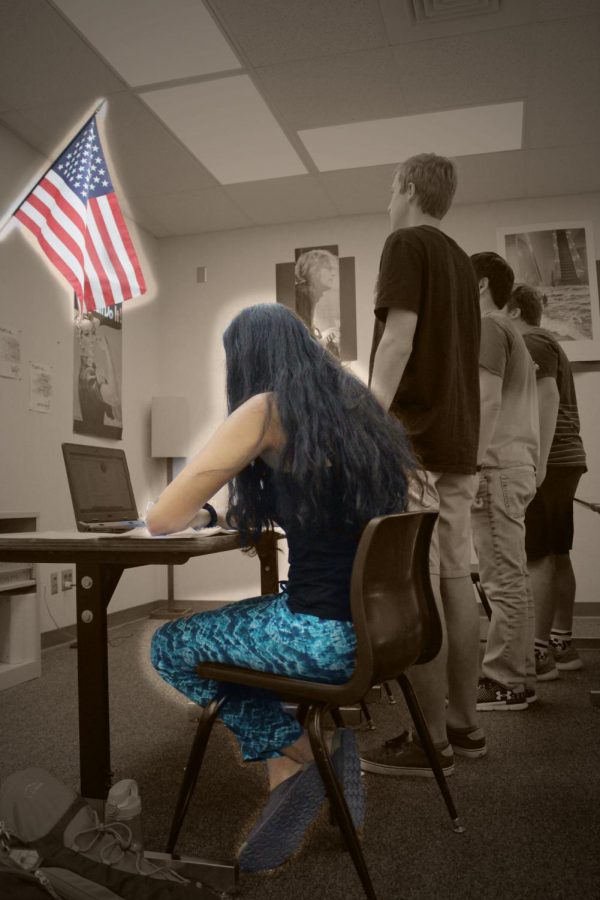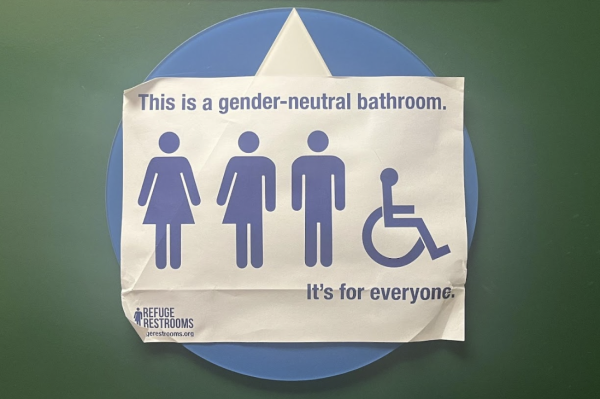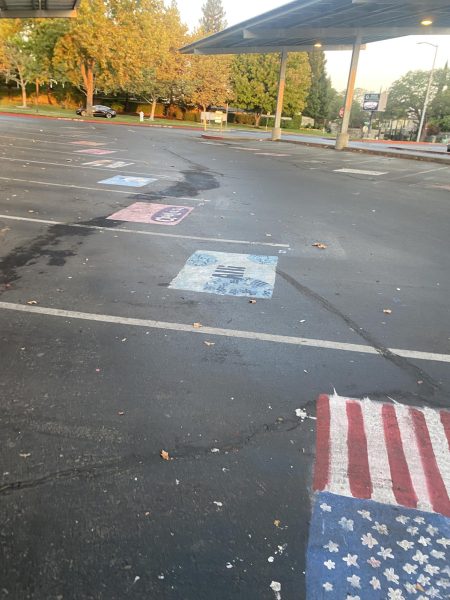To pledge or not to pledge
New controversy arises as students sit during Pledge of Allegiance
Despite all of the challenges recently faced in America, there is still a lot to be proud of.
The recitation of the Pledge of Allegiance has been an ongoing tradition within the public school system. It has become an action to which students have become accustomed once class starts, but the Pledge of Allegiance is not mandatory.
If students want to remain sitting during the Pledge, they can do so, and a teacher legally cannot tell them to stand.
The reasoning behind this: West Virginia State Board of Education v. Barnette (1943) ruled that it is unconstitutional to make a student stand for the Pledge because it violates the First and Fourteenth Amendments. This is due to the right for religious freedom and freedom of speech.
“People make this immediate judgement about somebody if they’re not standing, but it is the law,” Granite Bay High School Advanced Placement government teacher Jarrod Westberg said. “I understand why it’s the law. I understand why the courts ruled the way the courts have ruled, because our judges understand the constitution. Many people in the country do not.”
The portion of the Pledge of Allegiance that perhaps most often results in protest and controversy is the line “under God,” which was pushed by President Dwight D. Eisenhower to be added to the Pledge in 1954 during the Cold War.
“I would say that (“under God” is) an expectation of a Christian God in that sense that here we are trying to fight communism and what not, right, but without there (being) any clear definition,” said IB World Religions and English teacher David Tastor. “Every world religion except for Buddhism believes that there is a god, that there is some greater force bigger than us that we may or may not be dependent on.”
If the “under God” phrase is the only part that makes a student or teacher uncomfortable, the Ninth Circuit U.S. Court of Appeals ruled that they can simply omit the words when reciting the Pledge without receiving disciplinary punishment.
What was once thought of as possible way to bring people together during the Cold War and focus the fight against communism has drastically changed in today’s society.
“The whole idea of pledging your allegiance … is a big deal for our history, yes,” Westberg said. “It’s just today, it’s not something you would think is going to be a unifying issue.”
In September, a teacher in Michigan made sixth-grade student, Stone Chaney, stand during the Pledge and did so by forcing him out of his chair. What was his reasoning? Stone stopped standing for the Pledge in the second grade because he made a Pledge to his family and God, not to the flag.
“I struggle with the fact that a religious person, who’s only supposed to Pledge allegiance to God, is being required to Pledge allegiance to a flag, Tastor said.
“For me in studying religions, God is what you Pledge allegiance to, not a flag,” Tastor added. “So if it’s just simply a political connection, then there’s no need for the word ‘God.’ For the religious person who believes firmly in that aspect, I think that’s a conundrum that they have to solve.”
On the GBHS campus there are a number of students who don’t stand for the Pledge but many don’t have a particular reason.
Senior Divya Shetty hasn’t been standing for the Pledge for four years now.
“I don’t think it’s that important,” Shetty said. “I understand it’s meant to symbolize our loyalty for our country … but I find doing it every day unnecessary. It doesn’t really have any value for us, it’s not something I believe in, I guess.”
Shetty has always gotten neutral responses to sitting. She does occasionally get asked why she doesn’t stand, but nothing more.
The legal standard that students can’t be forced to Pledge doesn’t just apply to teachers exercising authority over students – it also applies to students trying to force other students or teachers to recite the Pledge.
In Westberg’s AP government class, he had an incident recently where a student told senior Julia Colby, who was sitting, to stand for the Pledge.
“I was doing my homework, and I only had a little time left before we were going to take a major exam for that class,” Colby said. “Everybody was standing for the Pledge, but I was sitting down and a person (in the class) was coughing and saying, ‘Excuse me!’ and I just stayed sitting.
“At the end, Westberg was saying that’s illegal to do and you’ll get in a lot of trouble.”
According to Westberg this hasn’t been normal in his class. Until recently.
“Here’s the weird thing,” he said. “So I’ve been teaching for 20 years and that was the first time seeing (a student try to force another student to stand for the Pledge). Not the first time seeing a kid not stand. So I connect that to what’s been going on in the (National Football League). I think people are making that connection because I have seen plenty of students in 20 years not stand. Never seen another student get mad.”
Unlike Westberg, who teaches government, other teachers and students often aren’t even aware of the law.
“I teach this stuff, so it’s different, but it freaks me out that we do not go into a process where we’re teaching our teachers these things,” Westberg said.
Rules that students and teachers likely aren’t aware of are that a student can leave the room during the Pledge as long as they are not a disruption, and a sitting student cannot prevent others from standing for the Pledge.
These legal standards apply not only to students, but to teachers as well. If a teacher objects to reciting the Pledge, the school district does not have the authority to make the teacher recite it.
With the political polarization in the country right now, this is one of the many dividing topics, but like everything else, there is a simple solution.
“I just wish people could hear each other out before the immediate knee-jerk reaction,” Westberg said. “It’s just so fast to jump on another person without knowing the law, without understanding the law.”
While Tastor would not ever try to insist that a student should stand for the Pledge, he understands and appreciates the significant role the flag plays in American culture.
“I do not believe that any teacher has the right to tell a kid to stand for that flag,” Tastor said. “I get its symbolism … but the long lineage of family who has fought in the military and died in the American military and the flag symbolizes (their sacrifice).
“But no one should be forced (to say the Pledge) in a country that professes it’s free.”













